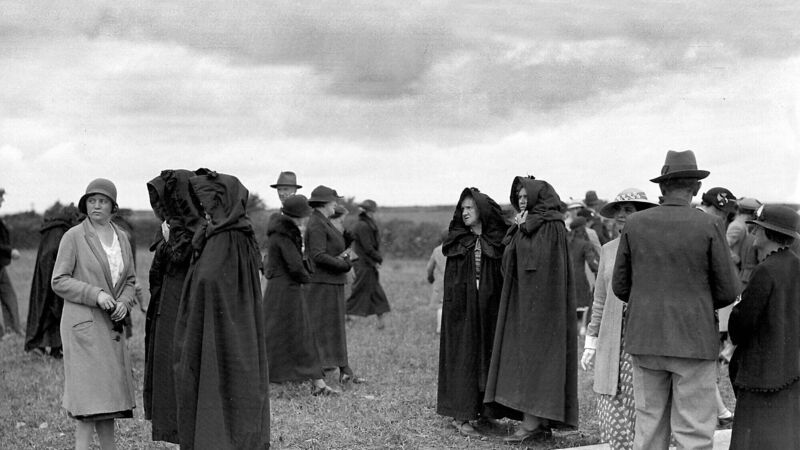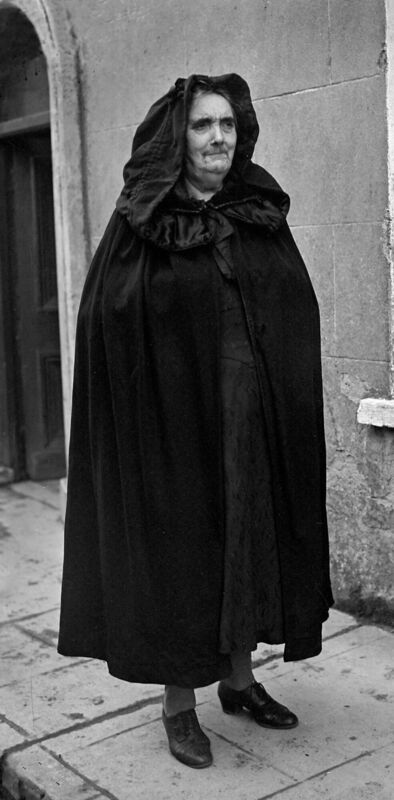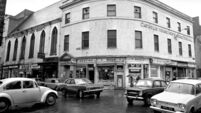Throwback Thursday: 'You never threw clothes out..I still have my gran’s West Cork cloak'

Old Irish traditional cloaks being worn in Kinsale in 1937
I was chatting to people down in Gougane Barra the other day, when the hotel was holding a special coffee morning in aid of Palestine.
The hotel restaurant itself was packed solid, but over in the old bar, it was quieter, with the fire burning brightly, and a few friends gathered for their Sunday chat as they often do.
Somebody mentioned an acquaintance having headed off for a bit of sunshine, as you tend to do in November these days. That got Sheila Canty reminiscing about her childhood holidays back in the 1960s.
“Our neighbours that time used to go off for their week or fortnight in Youghal or Crosshaven, and we were often envious of them, wishing our parents would do the same, but in fact we had great summer holidays ourselves as a family, now that I look back,” said Sheila.
“My father ran a garage in Ballincollig, and every summer, once the school holidays had started, he would hand my mother the keys to one of the cars he had there permanently, and she had the use of it for the whole summer, to take all of us anywhere and everywhere.
“He always told us not to bother so much about the petrol, but always – always - to check the oil and water. That was my job specifically, to look at those every time we set out for the day, and I can still hear him even now all these years later: ‘If you run out of petrol, the car will just stop. But if you run out of oil or water, the whole thing will blow up!’ And wasn’t he right?
“We went everywhere in County Cork. My grandmother had been brought up in West Cork and she had friends and relatives everywhere down there, so we would bring her with us and go visiting whoever was in the area we were headed for that day.
“They would welcome us with open arms, and then we kids would go rushing off to the beach or the hills or whatever was close by, while the adults sat and enjoyed a good talking session.
“My grandmother loved catching up with the local news, and so did my mother.”
Sheila recalls: “We had great trips in that car – it was usually the same one. I can still see it, a battered Morris Minor, with the number BIF 482.”
She was reminded of another aspect of childhood – and even teenage – days recently, when a grandson was looking for some really strong thread for something he was working on.
“I got out the old workbox to have a look, and when I opened it, well, what memories flooded out!
“Scraps of fabric from a summer dress of long ago, a paper pattern for a baby’s layette, snap fasteners, bits of tape, elastic, needles – and so many buttons! You didn’t throw away buttons back then, you always kept them because somebody would inevitably be needing another one sewn on.
“I showed a few of the really useful items in there to the grandkids, and they hadn’t a clue what they were, or what their purpose was. Yet we relied on them!”
Breda Lucey agrees.
“You never threw clothes out then. They were considered important and valuable items, for which you had paid good money. Shirt collars and cuffs got turned when they were worn, and even men’s overcoats.”

Overcoats got turned? Surely not.
But yes, Breda confirms, those big old heavy tweed overcoats that lasted a lifetime were regularly brought back to the tailor to be taken apart, linings and all, the fabric turned so that you had a new fresh face to the front, and then all sewn up again.
“Sure, the Tailor himself here in Gougane, he used to do that job for all the farmers,” added Breda.
She chuckles as she remembers a classic tale about ‘the Tailor and Ansty’.
“This farmer brought his coat in to be turned once the winter had finished, and kept going back to see if it had been done, but it never was.
“Eventually, he called to the cottage, determined to take it home again just as it was, since the autumn was fast approaching.
“Well, the Tailor couldn’t find it anywhere, hadn’t a clue where he had put it down, and then Ansty said, ‘Oh, is it that old thing? I put it under the broody hen!’ ” Breda peals with reminiscent laughter.
She still possesses her grandmother’s traditional West Cork cloak, that emblem of matronly dignity once worn with pride by all older women in this part of the world.
“It’s very long – she was a tall woman – and it is very heavy too. They created them to last, the old cloakmakers, to hold out the wind and the rain and the mud.
“Good, thick wool, which was woven in Bantry – now what was the name of the weaving mill? And a black satin lining.”
A characteristic of these traditional cloaks was the heavily-gathered hood which lay around the shoulders almost like a second layer of warmth until it was pulled up to cover the head and shroud the face from inquisitive glances.
This writer remembers a Ms McCarthy in Macroom, who ran an antique shop, talking of her own mother’s cloak which she, like Breda, still possessed and valued, and telling me that in her childhood there were no fewer than five cloakmakers in the town, all of them busily employed in stitching these purchases of a lifetime.
Back then, clothes were expensive, you saved up for them, and you expected them to last for your own time and beyond.
It was common up to even the 19th century for people making a will to mention specific items of clothing that should be left to particular descendants. They could simply not have conceived of the throwaway society we have today.
Asked if she ever made any of her own clothes, Sheila Canty is surprised at my question.
“Of course I did! We all did back then. I would head into town in the morning, buy a few yards of a pretty print fabric, take it home, lay it out on the kitchen floor and cut out the pattern, sew it up on my mother’s old hand-cranked machine, and wear it to a dance by Christians or Pres’ that night!
“You only needed two or three yards of cotton for a shift dress, barely a yard for a mini skirt, depending on whether it was 36” wide or 45”.”
Katie O’Brien chirps up from the other side of the fireplace at Gougane Barra hotel to agree.
“Oh, the times I rushed out to buy some new cotton from Roches Stores because there was a Pres’ dance that night and I wanted to be the belle of the ball! It took no time at all to sew up a shift dress.
“I even made myself a velvet trouser suit once, but that took a bit of time, and velvet is very tricky to work with, you have to lay it with the nap facing upward, not down.”
Katie confesses that, although she, like everyone else, progressed from treadle and hand-cranked Singers to the latest electric models, she has recently gone back to an antique hand-crank.
“It’s so much more relaxing to use,” she explains. “You aren’t constantly being second-guessed by the trendy computerised machine that either runs away with you or stops short, brings up the blue screen of death, and issues a sharp reprimand because you haven’t pressed the absolutely right button.”
You do have a point, Katie. Do any other readers find modern electronic whiz-kid machines a bit stressful? That would include the latest designs in mobile phones too. Who remembers when you just dialled up from the black phone standing in the hallway? Or even went out to the box on the corner with a few pennies, to make that vital contact – only to find the district’s worst gossiper comfortably ensconced in there, and looking like staying there for the day?
Best of all, do you remember simply making dates in advance with your friends for such time in such a place on such a day, and then keeping it, rather than doing it all on the spur of the moment? (Mangan’s clock at three on Tuesday? Savoy steps, Saturday morning?) Come on, let us know!
Come to that, how long is it since you repaired something rather than just throwing it out? No, truthfully.
If you can remember the ’50s and ’60s, you will certainly recall your father hammering something back together again out in the shed, and your mother sitting down with a basket of mending, repairing a rip in trousers (wish he wouldn’t climb those barbed wire fences!), sewing on buttons, darning socks (can’t think how he gets these holes in them).
As we were reminded by Breda and Sheila further up this page, you valued the investment that had been made in the clothes you wore, and had been taught (or should have been!) all the skills necessary to keep them looking good for as long as possible.
Remember when you could buy a card of strong, waxed thread plus needle from the cobbler, to mend your shoes? Back when there were cobblers and shoe repair shops on every street?
And didn’t every household have a box out the back, in the scullery or shed, with polish tins (both black and brown) and separate brushes for both?
Can anybody recall polishing their shoes on Saturday night in preparation for going to Mass on Sunday morning? It used to be mandatory in every household. (Have you noticed that the male newsreaders on RTÉ always have perfectly polished shoes? Is there someone back stage to see to that?)
The point is that we used to have far more skills than we do now.
Yes, today’s kids can perform amazing tricks with their smartphones, talk across the world on WhatsApp, download the latest music, and post to international chat groups.
I saw a baby in a pram the other day, well propped up on cushions, absorbed in a colour video on his mother’s phone which he clutched firmly.
At an age when you would have wondered if he could even hold his bottle properly, the baby was actually sweeping his chubby little finger across the screen competently, to bring up another picture, another scene.
But is anybody teaching our youngsters to sew on their own buttons, darn that hole in their sweater, or turn up their own new jeans rather than rushing to a dressmaking shop?
Do small boys make bird tables any more? Do small girls not use their creativity to make their own party costumes out of sheets and curtains and muslin drapes, rather than going into Lidl or Dunnes and buying them ready-made?
What happened to all those old skills which fathers taught to their sons, mothers to their daughters? There was real joy in creating something new out of the old, in repairing something torn or broken.
What do you think happened when a wheel came off one of those classic old Cork ‘trolley-waggers’ or ‘steerinahs’ after a particularly bumpy trip down Patrick’s Hill? Did the proud owners chuck it on the scrap heap? Did they heck.
Back to the nearest friendly garden shed, possibly seek some advice from a wise father, then nails, screws, pliers, hammer… and they would be back out on the road, risking life and limb once more.
Sure, what else would you do?
Let’s hear your views and memories. Email jokerrigan1@gmail.com or leave a comment on our Facebook page: www.facebook.com/echolivecork.







